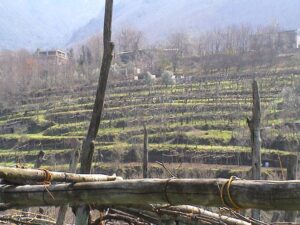MUNICIPALITY: Ravello
NAME: Villa Cimbrone
LOCATION: Via S. Chiara
DESCRIPTION:The architectural situation of the villa, currently used for accommodation purposes and therefore not visitable in all its parts, appears very complex because we know little of the original structures (it belonged to the Acconciagioco family) compared to the great work of monumetalization that took place in the early years of the last century, when the new owner, Lord Bercket Grimthorp, entrusted the rearrangement of the area to a man from Ravello named Nicola Mansi.
From the entrance alley, one can already see the palace, which recalls the forms of an embattled castle, complete with tower and arched window compartments, emphasized by color plays made of tuff. Another tower, with a final tiled spire, reproduces in elevation the structure of the bell tower of St. Martin’s Church.
The rooms of the palace, all vaulted and frescoed, show majolica floors of medieval taste and rich furnishings, with fireplaces in almost every room.
The cloister is visitable, with mullioned windows framed by pointed arches and resting on twisted columns, with the well balustrade in the center, all built reworking the imitation of cloisters found on the Coast.
The so-called Tea-room, next to the palace, is also interesting and can be visited, reproducing shapes proper to the Islamic palace; it is, in fact, a rectangular-plan building that has one long side open to the rose garden through arches held up by slender pillars decorated with majolica and interlacing motifs. Classically inspired statues adorn the rose garden.
Underneath the main body of the building was created a crypt in imitation of the dining room of Villa Rufolo, with octagonal shaft pillars from which branch twisted columns.
Visitable in all its breadth and beauty remains the park, with the avenue ending in the breathtaking Belvedere, which is accessed through a kind of four-sided monumental arch, where a reproduction of a Greek statue makes a fine display.
A reproduction of a circular classical temple houses, nestled in the park’s gardens, the ashes of Lord Bercket, while numerous statues (among them the Venus in the Cave) grace the terraces.
SEE, VISIT, FIND: The privately-owned villa can be visited only for the garden and cloister portion by purchasing a ticket at the entrance.
FRUITION DATA: None
OPPORTUNITIES: It is necessary to supplement the information already present with more comprehensive texts on the history of the Villa and the various evidences, especially on the Belvedere, because not all visitors use the guidebooks on the market. The presentation of the Villa could also be enriched with references to the history of foreign presences in Ravello.
BIBLIOGRAPHY: IMPERATO G., Ravello nella storia civile e religiosa, Cava d. T. 1990.





